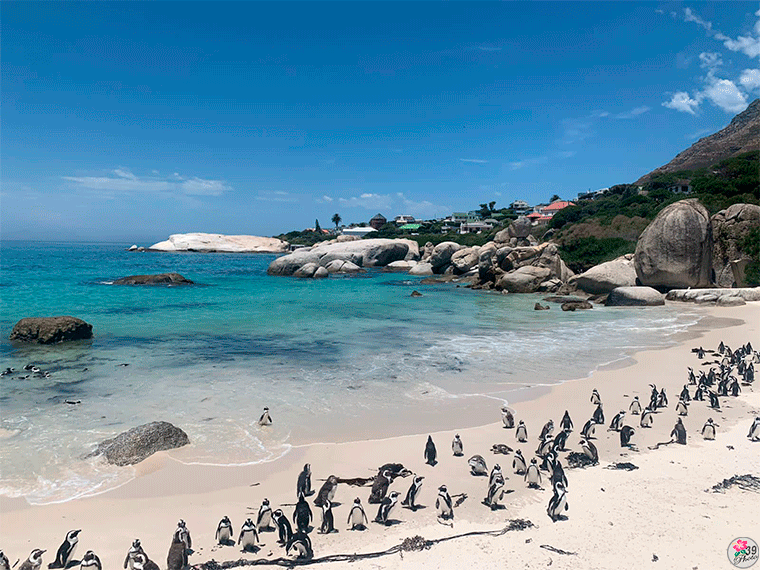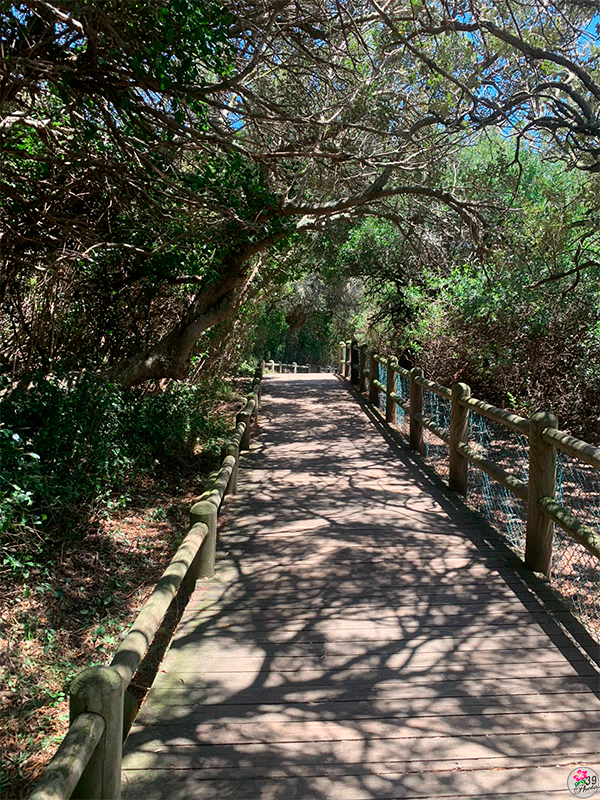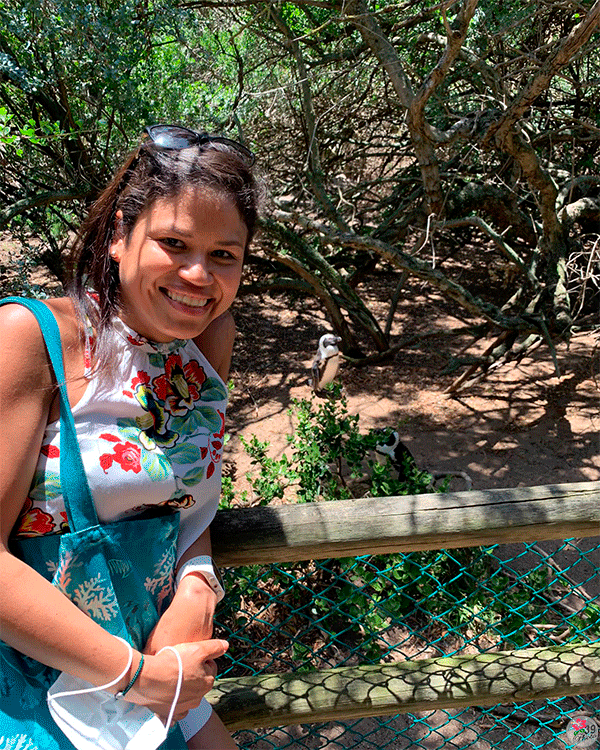El Spheniscus demersus: Una importante ave marina en peligro de extinción | The Spheniscus demersus: An important seabird in danger of extinction.
01/02/2022
By: @flores39
La diversidad biológica como tesoro evolutivo
Una de las maravillas más inspiradoras de la evolución de la Tierra es la compleja diversidad biológica que emergió a través de su transformación geológica, topográfica, climática y ambiental en general; por ejemplo, la fractura y ensanchamiento del supercontinente Gondwana en el extremo suroccidental dio origen a Sudamérica y constituyó el inicio de un grandioso litoral en Sudáfrica y territorios adyacentes que son bañados por las frías aguas del océano Atlántico, el cual ha sido fundamental para formar un hermoso ecosistema marino costero.

El gran choque y fractura del supercontinente Gondwana solo fue el inicio de un mágico ecosistema mediterráneo y tropical sudafricano, muchos de sus aliados continúan activos terminando de moldear el paisaje; este encadenamiento de eventos ameritó la colaboración colosal de los procesos de subducción, cabalgamiento y elevación de capas oceánicas, erosión y arrastre de sedimentos coralinos, esparcimiento de partículas rocosas formadas por areniscas, entre otros.
Fue así como la inteligencia y fuerzas naturales quiso que la península de Ciudad del Cabo contara con excepcionales condiciones ambientales y ecológicas para albergar apreciables especies, entre estas muchas aves de origen marino, el Spheniscus demersus es una de ellas, popularmente se le conoce como pingüino sudafricano.

Te cuento que fortuitamente he tenido el privilegio de visitar Boulders Beach, que forma parte del Parque Nacional Montaña de la Mesa y está fuertemente influenciado por áreas residenciales; a pesar de su zonificación urbana es un hermoso lugar donde convive una adorable colonia de pingüinos que trata de mejorar sus mecanismos de supervivencia para no desaparecer, puesto que se encuentra bajo amenaza de extinción.
Por casualidad ¿Has estado aquí? En esta ocasión, comparto mi experiencia y opinión en esta aventura de turismo ecológico.
El Pingüino africano (Spheniscus demersus)
Las densas lagunas existentes en los anales históricos de fósiles impiden precisar con exactitud desde cuando apareció el Spheniscus demersus en la región africana; sin embargo, en 2010 se reveló información determinante sobre la posible existencia de al menos cuatro especies de pingüinos que habitaron múltiples playas de la salvaje costa sudafricana hace más de 10 millones de años. La investigación que estuvo dirigida por Daniel Thomas del Museo Nacional de Historia Natural y Dan Ksepka del Centro Nacional de Síntesis Evolutiva, fundamentó sus resultados en la recolección y análisis de 17 fragmentos de fósiles de diferentes zonas de la anatomía de estas aves. Fuente

Ahora bien, teniendo un marco temporal sobre el origen y poblamiento de estas aves en las costas africanas, se puede deducir que la extinción de las restantes tres especies prehistóricas no se debió a causas antropógenas, puesto que el Homo sapiens aparece hace unos 100.000 años, según estudios de restos fósiles encontrados en las adyacencias del río Klasies en la provincia del Cabo del Este. No obstante, desde mediados de 2010, se ha lanzado la alerta de peligro de extinción debido a cusas asociadas a la actividad humana y en menor proporción a depredadores.
Después de originarse y evolucionar en un hábitat prístino, hoy en día estas aves con plumaje espeso e impermeable con tonalidades negra y blanco que le hacen lucir elegantes al caminar y veloces al bucear, pueden observarse a corta distancia por su empático comportamiento social e incluso con los humanos. Su corta estatura y estruendoso rebuznar capturan la atención de lugareños y visitantes; pues sí, emiten un agudo sonido que emula el lenguaje de los burros.

Se dice que es su estilo comunicativo al momento de cortejar a su candidata o pretendiente. Son especies monógamas que permanecen unidas durante la reproducción y después de formar su familia, es decir hasta la muerte.
Una criatura carismática y sociable
En las blancas arenas de origen coralino y areniscas rocosas de Boulders Beach podemos observar y tratar de comprender el comportamiento social de esta colonia de pingüinos africanos que alternan su tiempo en tierra firme y el mar; algunos pueden alejarse hasta 30 kilómetros o más en busca de alimento, en el caso de parejas con polluelos prefieren recolectar su alimento cerca de los nidos para proteger su cría.

Emplean tres tipos de sonidos que difieren en cuanto a su uso, la vocalización es emitida para infundir su respeto ante los demás, para atraer a su pareja y para comunicarse con su cría en caso que se extravíen o se encuentren en peligro. Durante las horas que estuve observándolos, no visualicé algún conato de agresividad entre ellos; algunos correteos con alas abiertas que terminaban en coqueteos en la arena.
Por qué es una especie en peligro de extinción
Los gustos gastronómicos a partir del consumo de huevos de pingüinos africanos en la cocina local y europea, llamaron la atención de las autoridades ambientales a final de la década de 1970; la recolección indiscriminada de huevos y destrucción de nidos para satisfacer sombrías necesidades económicas y culinarias hicieron mermar drásticamente la población de la especie en las costas africanas.

La intervención humana no se detuvo en considerar un manjar la postura de ave, sino que muchos pobladores vieron el guano como una fuente adicional de ingreso económico que a su vez iba a mejorar las condiciones agrícolas por utilizar este potente fertilizante sin importar la degradación del hábitat natural.
En definitiva, la figura de área bajo protección frenó el avance explotador hacia esta especie endémica. Ahora hay que lidiar con otros factores, siendo uno de ellos el energético; no es un secreto la afectación que los derrames de petróleo ocasionan a las aguas marinas cercanas a los asentamientos de pingüinos africanos; la pesca de arrastre y otros métodos agresivos que se practican están disminuyendo la biomasa marina y esto dificulta la obtención de alimentos, obligando a los pingüinos a nadar a zonas más lejanas donde quedan expuestos a depredadores.

Esto complica el panorama durante la época de reproducción, puesto que los huevos y polluelos quedan indefensos en los nidos.
Se trata de una especie que desarrolló un comportamiento sentimental en lo maternal, no soportan vivir el sufrimiento de ver morir a su cría por escacez de alimento, es por eso que prefieren abandonarlas antes que pasar la amarga experiencia de fallecimiento por desnutrición.

Todo esto y más se conoce por muchos años de estudio, una política ecológica eficaz de protección animal y preservación del hábitat contribuiría de gran manera para remediar la situación en la que se encuentran las 27 colonias de pingüinos africanos.
Caminerías de madera
|
|
|


El extremo de la baranda que limita con la playa y su planicie rocosa con arbustos, se encuentra protegida con malla de polietileno para impedir que las aves migren a la zona urbana.

Una de las curiosidades anatómica y biológica de esta especie es su sensor termoregulador, el cual utiliza para equilibrar su temperatura al bombear más cantidad de sangre a esta membrana para que funcione como un sistema de enfriamiento.

Durante el recorrido por el circuito de caminería pude observar muchos ejemplares que se encontraban sombreando bajo los arbustos y otros que anhelaban cruzar el cercado.


Durante el recorrido se encuentran avisos informativos sobre la especie y su ciclo de vida, así como algunas recomendaciones ecológicas para preservar la especie.

El espléndido paisaje marino costero con su verde vegetación arbustiva y decorativas rocas no dejan de capturar la atención de los visitantes.

Las azules aguas del Atlántico parecen haber tomado su color del celeste firmamento que se diferencia del mar por su dispersa nubosidad y altura.




One of the most inspiring wonders of Earth's evolution is the complex biological diversity that emerged through its geological, topographical, climatic and general environmental transformation; for example, the fracturing and widening of the supercontinent Gondwana in the extreme southwest gave rise to South America and constituted the beginning of a great coastline in South Africa and adjacent territories that are bathed by the cold waters of the Atlantic Ocean, which has been fundamental to form a beautiful coastal marine ecosystem.

The great collision and fracture of the supercontinent Gondwana was only the beginning of a magical South African Mediterranean and tropical ecosystem, many of its allies are still active and continue to shape the landscape; this chain of events required the colossal collaboration of the processes of subduction, thrusting and uplift of oceanic layers, erosion and dragging of coral sediments, spreading of rock particles formed by sandstones, among others.
It was in this way that the intelligence and natural forces wanted the Cape Town peninsula to have exceptional environmental and ecological conditions to host many species, among these many birds of marine origin, the Spheniscus demersus is one of them, popularly known as South African penguin.
I tell you that fortuitously I have had the privilege of visiting Boulders Beach, a beautiful place where there is a lovely colony of penguins trying to improve their survival mechanisms to avoid disappearing, since it is a species under threat of extinction. By any chance, have you been here? On this occasion, I share with you my experience and opinion about it.
Spheniscus demersus (Afrikanischer Pinguin)
Dense gaps in the historical fossil record make it impossible to pinpoint exactly when Spheniscus demersus first appeared in the African region; however, in 2010, decisive information was revealed about the possible existence of at least four species of penguins that inhabited multiple beaches on the wild South African coast more than 10 million years ago. The research, led by Daniel Thomas of the National Museum of Natural History and Dan Ksepka of the National Center for Evolutionary Synthesis, based its results on the collection and analysis of 17 fossil fragments from different areas of the anatomy of these birds. Source

Now, having a time frame on the origin and settlement of these birds on the African coasts, it can be deduced that the extinction of the remaining three prehistoric species was not due to anthropogenic causes, since Homo sapiens appeared about 100,000 years ago, according to studies of fossil remains found in the vicinity of the Klasies River in the Eastern Cape province. However, since mid-2010, an extinction danger alert has been issued due to causes associated with human activity and, to a lesser extent, predators.
After originating and evolving in a pristine habitat, today these birds with thick, waterproof plumage in black and white hues that make them look elegant when walking and swift when diving, can be observed at close range for their empathetic social behavior and even with humans. Their short stature and thunderous braying capture the attention of locals and visitors alike; yes, they emit a high-pitched sound that emulates the language of donkeys. It is said that this is their communicative style when courting their candidate or suitor. They are monogamous species that remain united during reproduction and after forming their family, that is, until death.
A charismatic and sociable creature
In the white sands of coral origin and rocky sandstones of Boulders Beach we can observe and try to understand the social behavior of this colony of African penguins that alternate their time on land and at sea; some can move up to 30 kilometers or more in search of food, in the case of pairs with chicks they prefer to collect their food near the nests to protect their offspring.

They use three types of sounds that differ in their use, the vocalization is emitted to instill their respect to others, to attract their mate and to communicate with their young in case they get lost or are in danger. During the hours that I was observing them, I did not visualize any aggression between them; some scurrying with open wings that ended in flirtations in the sand.
Why it is an endangered species?
The gastronomic tastes from the consumption of African penguin eggs in local and European cuisine caught the attention of the environmental authorities at the end of the 1970s; the indiscriminate collection of eggs and destruction of nests to satisfy grim economic and culinary needs drastically reduced the population of the species on the African coasts.

Human intervention did not stop at considering the bird's posture as a delicacy, but many settlers saw guano as an additional source of economic income that in turn would improve agricultural conditions by using this potent fertilizer regardless of the degradation of the natural habitat.
Ultimately, the protected area status slowed down the exploitative advance of this endemic species. Now we have to deal with other factors, one of them being energy; it is no secret that oil spills are affecting the marine waters near the African penguin settlements; trawling and other aggressive methods are reducing the marine biomass and this makes it difficult to obtain food, forcing the penguins to swim to more distant areas where they are exposed to predators.

This complicates the situation during the breeding season, since the eggs and chicks are left defenseless in the nests.
This is a species that has developed a sentimental maternal behavior; they cannot bear the suffering of seeing their young die from lack of food, which is why they prefer to abandon them rather than go through the bitter experience of death due to malnutrition.

All this and more is known from many years of study, an effective ecological policy of animal protection and habitat preservation would contribute greatly to remedy the situation in which the 27 colonies of African penguins find themselves.
Wooden walkways
|
|
|


The end of the railing bordering the beach and its rocky plain with shrubs is protected with polyethylene mesh to prevent birds from migrating to the urban area.

One of the anatomical and biological curiosities of this species is its thermoregulatory sensor, which it uses to balance its temperature by pumping more blood to this membrane to function as a cooling system.

During the tour of the walking circuit I could see many specimens that were shading under the bushes and others that longed to cross the fence.


During the tour there are informative notices about the species and its life cycle, as well as some ecological recommendations to preserve the species.

The splendid coastal seascape with its green shrub vegetation and decorative rocks never fails to capture the attention of visitors.

The blue waters of the Atlantic seem to have taken their color from the celestial firmament that differs from the sea by its dispersed cloudiness and height.



Translated with www.DeepL.com/Translator (free version)
📷 Sobre las imágenes | About the images 📷
Las imágenes son propiedad de la autora, tomadas con dispositivo smartphone, marca Appel, modelo iPhone X.
The images are property of the author, taken with smartphone device, Appel brand, model iPhone X.


Congratulations, your post has been added to Pinmapple! 🎉🥳🍍
Did you know you have your own profile map?
And every post has their own map too!
Want to have your post on the map too?
Congratulations @flores39! You have completed the following achievement on the Hive blockchain and have been rewarded with new badge(s):
Your next target is to reach 200 posts.
You can view your badges on your board and compare yourself to others in the Ranking
If you no longer want to receive notifications, reply to this comment with the word
STOPTo support your work, I also upvoted your post!
Check out the last post from @hivebuzz:
Support the HiveBuzz project. Vote for our proposal!
Hermoso animal, es una lastima que su vida se este perdiendo
Con una buena dósis de consciencia ecológica y política ambiental de protección, se irá minimizando el impacto negativo que está dañando su especie. Esperemos que así sea.
Gracias por comentar,
Whoaaa, so many penguins in one place.
@tipu curate
Upvoted 👌 (Mana: 70/90) Liquid rewards.
Although the colony's population has suffered a severe decline due to the above, in recent years there has been a slight recovery thanks to the institutional work of specialized equipment and because it is located in a protected area. It is a wonderful experience.
Thank you for your comment and valuable support.
Thank you for your comment and valuable support.
Thank you for sharing this amazing post on HIVE!
Your content got selected by our fellow curator @ashikstd & you just received a little thank you via an upvote from our non-profit curation initiative!
You will be featured in one of our recurring curation compilations and on our pinterest boards! Both are aiming to offer you a stage to widen your audience within and outside of the DIY scene of hive.
Join the official DIYHub community on HIVE and show us more of your amazing work and feel free to connect with us and other DIYers via our discord server: https://discord.gg/mY5uCfQ !
If you want to support our goal to motivate other DIY/art/music/homesteading/... creators just delegate to us and earn 100% of your curation rewards!
Stay creative & hive on!
Congratulations @flores39! You received a personal badge!
You can view your badges on your board and compare yourself to others in the Ranking
Check out the last post from @hivebuzz:
Support the HiveBuzz project. Vote for our proposal!